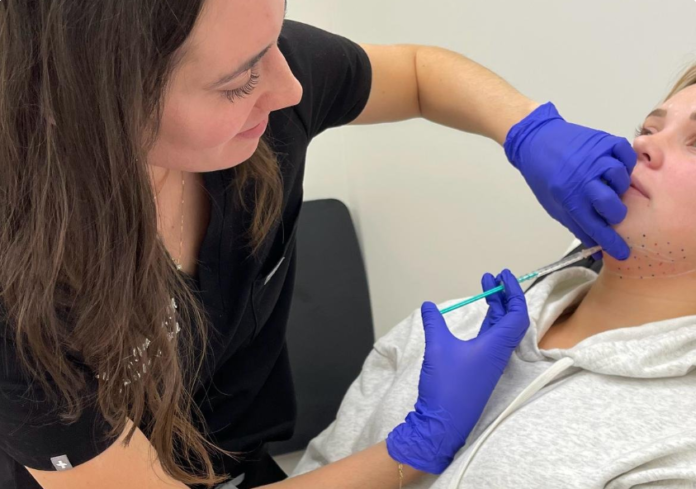Dermal paddings are a popular ornamental treatment that can help restore volume, smooth out wrinkles, and enhance facial features. However, to achieve the best results and maintain your desired look, it’s crucial to follow certain guidelines before and after the procedure. This ensures optimal issues and minimizes implicit side goods. Here are seven essential tips for dermal fillers before and after face treatment that you should keep in mind.
- Consult with a Qualified Professional
Before considering dermal fillers, it’s vital to consult with a certified and experienced professional. They will assess your skin type, discuss your goals, and recommend the best type of filler for your needs. A thorough discussion helps insure that your prospects align with what’s attainable. During this consultation, make sure to ask about the different types of fillers available, such as hyaluronic acid-based fillers, and the expected results for each. At Allie Aesthetics, our experts prioritize patient safety and satisfaction, offering personalized advice to help you achieve your desired look. For more info Dermal fillers USA
- Prepare Your Skin Before the Treatment
Proper skin preparation can significantly impact the results of your dermal filler treatment. About a week before your appointment, avoid using any products that can irritate your skin, similar as retinoids or exfoliants. It’s also recommended to avoid alcohol and blood-thinning medications like aspirin, as they can increase the risk of bruising. Staying hydrated and maintaining a healthy diet can also support your skin’s condition, making it more receptive to the treatment. Your skincare routine plays a crucial role in ensuring the smooth application of fillers.
- Know What to Anticipate During the Procedure
Understanding the process of getting dermal fillers can help alleviate any anxiety you may have. Typically, the procedure involves a series of injections into targeted areas, which may cause a slight pinching sensation. Most professionals apply a numbing cream before the injections to minimize discomfort. The treatment usually takes around 30 to 60 minutes, depending on the areas being treated. Knowing what to expect during the procedure helps you feel more comfortable and prepared. At Allie Aesthetics, we make sure our clients are well-informed and relaxed throughout the process. For more info Click here
- Follow Post-Treatment Care Instructions
Proper aftercare is essential for minimizing swelling and bruising after dermal fillers. Your provider will give you specific instructions to follow, such as avoiding strenuous exercise, hot baths, or saunas for at least 24-48 hours post-treatment. You may also be advised to avoid applying pressure to the treated areas, similar as when sleeping on your face. Applying ice packs to the treated areas can help reduce swelling, but always consult your provider before doing so. Following these aftercare steps ensures a smoother recovery and longer-lasting results.
- Be Patient with the Results
The results of dermal paddings can take some time to completely settle. It’s common to experience minor swelling or redness immediately after the procedure, which can take a few days to subside. Most patients begin to see the final results within 1-2 weeks. It’s important to be patient during this time and avoid assessing the results too early. Rushing back for more treatments before the filler has settled can lead to overfilling and undesirable outcomes. Trust the process, and allow your body the time it needs to adjust to the changes.
- Schedule Follow-Up Appointments
Scheduling follow- up movables with your provider is an important part of the dermal padding trip.These sessions allow your provider to assess the results, address any concerns, and recommend touch-ups if needed. Dermal fillers are temporary, and regular maintenance can help preserve your desired look. Depending on the type of padding used, touch- ups may be needed every 6- 12 months. Regular follow-up appointments also ensure that your filler is aging naturally with your face, maintaining a balanced and refreshed appearance.
- Know the Signs of Complications
Although dermal fillers are generally safe, it’s essential to be aware of potential side effects or complications. Common side effects include mild swelling, bruising, and redness, which should subside within a few days. However, if you experience severe pain, prolonged swelling, or unusual symptoms such as lumps or discoloration, contact your provider immediately. Early discovery of complications can help more serious issues. At Allie Aesthetics, patient safety is our top priority, and we provide thorough guidance on how to recognize and address any concerns post-treatment.
Conclusion
Dermal fillers can enhance your natural beauty and boost your confidence when performed and cared for properly. By following these seven essential tips before and after your treatment, you can achieve the best possible results while minimizing risks. Remember to consult with a qualified professional, prepare your skin, understand the procedure, follow aftercare instructions, be patient, attend follow-up appointments, and stay vigilant for any complications. For further information and to bespeak a discussion, visit Allie Aesthetics. With the right approach, you can enjoy smooth, youthful-looking skin and a revitalized appearance that lasts.
